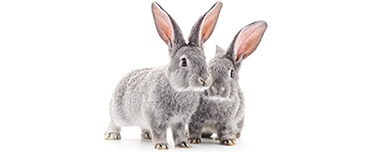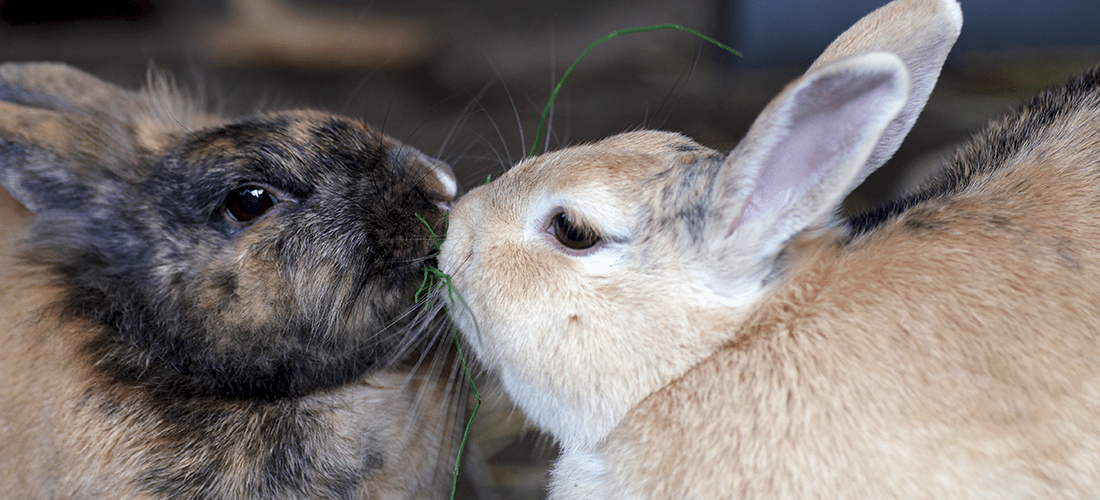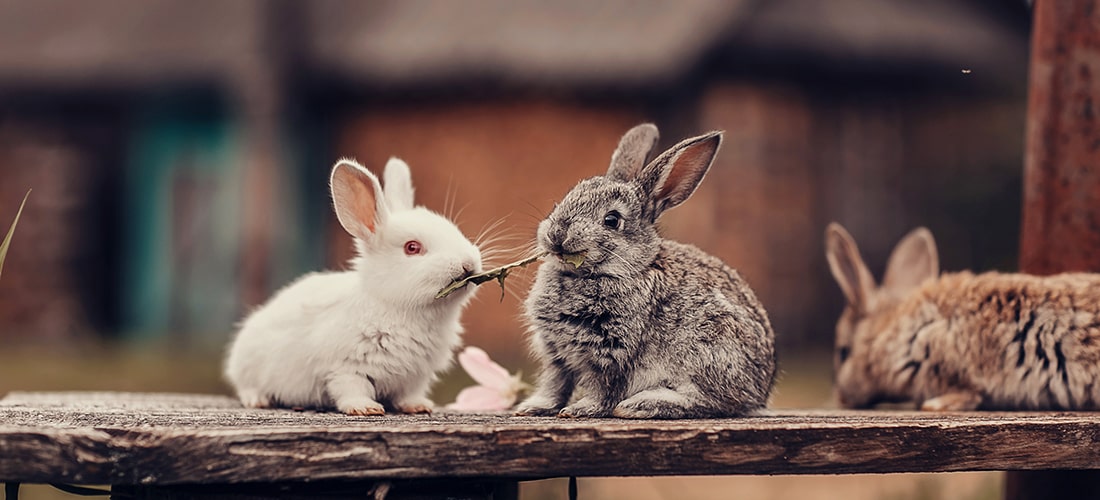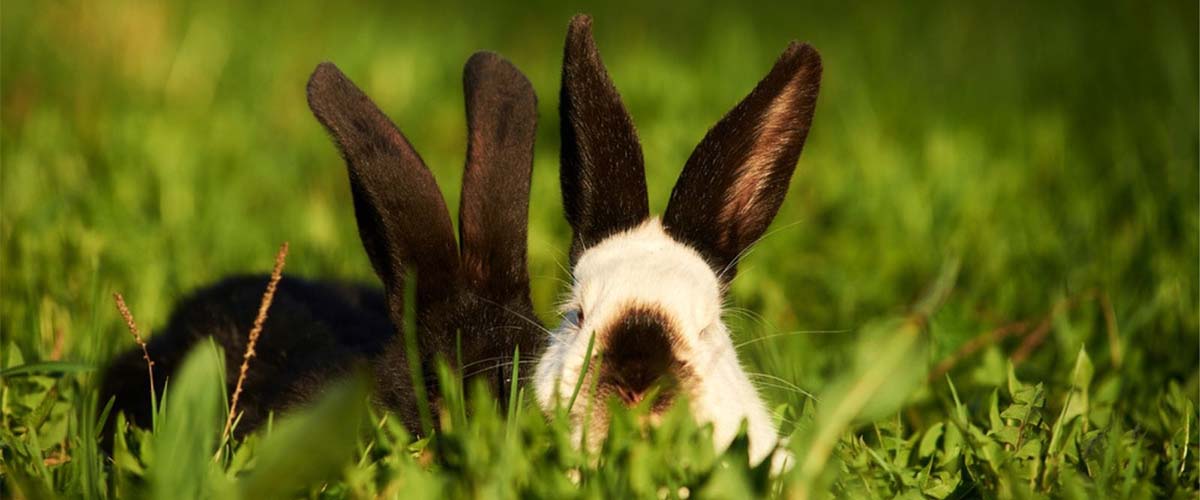Rabbit neutering: castration and spaying guide

Overview
- We recommend neutering all pet rabbits to prevent unwanted pregnancies and avoid health problems like ovarian and testicular cancer. Neutered rabbits also tend to be more sociable/less likely to fight with other bunnies.
- Neutering a male rabbit is called ‘castration’ and involves removing the testicles. This can be done from around ten weeks of age.
- Neutering a female rabbit is called ‘spaying’ and involves removing the ovaries and womb. This can be done from around five months of age.
- Rabbits are able to get pregnant at around three months old, so males and females must be kept separate from this age (ideally a bit before), until after they have been neutered.
- Male rabbits can remain fertile for up to six weeks after they have been castrated, but females are sterile immediately.
Reasons to have your rabbit neutered
Pregnancy
- The most obvious risk of being unneutered is pregnancy, and most rabbits can get pregnant at around three months old, even if they are related!
Illness
- By neutering your rabbits you decrease/eliminate the risk of certain cancers, for example uterine and testicular cancer.
Fighting
- Rabbits are sociable animals so should always be kept in pairs or groups, neutering them means they are much less likely to fight.
- Neutered rabbits are also much less likely to show aggression towards people.
- The ideal pairing is usually a neutered male and neutered female – read more about giving your rabbits the company they need.
Urine spraying
- Neutered rabbits are less likely to spray urine to mark their territory.
The procedure
Before the op
- Unlike cats and dogs, rabbits don’t need to be starved before surgery, so there is no need to withhold their food or water.
- Take some of their own food, hay and fresh greens to the vets with them.
- If possible, take them to the vets with another rabbit they are bonded with – and let your vet know this is what you would like to do.
The operation
- Your vet will check your rabbit, give them a light sedative, some pain relief, and settle them in a warm, comfortable bed.
- Once the sedation has taken effect, your rabbit will be put under a full/general anaesthetic.
- They will then be carefully monitored, while they are clipped and cleaned ready for surgery.
- They will be given blankets to keep them nice and warm.
- If your rabbit is female, your vet will make a small incision along the middle of her abdomen (tummy) so her ovaries and uterus (womb) can be carefully removed.
- If your rabbit is male, your vet will make a small incision over each testicle so that they can be carefully removed.
After the op
- Your rabbit will wake up from their anaesthetic under the careful watch of a vet/vet nurse and be placed in a warm, comfortable bed to recover.
- It’s important your rabbit starts eating again quickly after they wake up to prevent gut stasis (when the guts stop working properly). They will be monitored closely, and if necessary, might be syringe fed their first meal.
- Most rabbits can return home a few hours after their operation, but if your rabbit takes a bit longer to come round from their anaesthetic, or doesn’t start eating again quickly, they may need to be monitored for longer.

Rest and recovery
- When your rabbit first comes home, they might be a bit sleepy and disorientated. This can last for several hours, but they will start to feel much more normal as the anaesthetic drugs leave their body (usually within 24-48 hours).
- Keep your rabbit with their bonded partner, and give them a quiet, calm place to relax.
- Give them some of their favourite greens, as well as their normal hay, and pellets.
- Monitor them, and call your vet for advice if you have any concerns i.e. if they aren’t eating, seem quiet, or you see a runny poo in their cage.
Home care and check-ups
- It’s important that you keep a close eye on your rabbit to make sure they are eating normally, pain free, and well in themselves.
- Keep their living space very clean, try to keep them away from dusty bedding, mud, or anything else that could cause a wound infection.
- Check their wound at least twice a day, to make sure it’s clean and none of the stitches have come loose or been nibbled.
- It’s likely that your rabbit will need a check-up at your vets a few days after their operation to make sure they are healing and feeling okay after their anaesthetic.
- Call your vet for advice if you have any concerns before their check-up.
Stitch removal
- You may be able to see stitches in your rabbit’s wound depending on whether your vet used dissolvable or non-dissolvable stitches.
- Dissolvable stitches can’t be seen and don’t need removing.
- Non-dissolvable stitches can be seen and tend to need removing 7-14 days after the operation.
Possible complications
Neutering is a relatively safe, routine procedure, performed by most vets on a daily basis. However, like any operation there are always risks and the potential for complications during and after the surgery. Your vet will discuss the risk with you beforehand – don’t hesitate to ask questions if you have any concerns.
Gut stasis
- One of the main risks of rabbit neutering is gut stasis; a condition that causes the guts to stop working.
- It’s most likely to develop if your rabbit becomes stressed and stops eating.
- If necessary, your vet will give your rabbit medication to keep their guts moving, but there are also some things you can do to reduce the risk of gut stasis, such as:
- Keep them with their bonded partner rabbit before, during, and after their trip to the vets.
- Take them to the vets with some of their own feeding hay, fresh greens, and pellets.
- Give them a quiet, calm environment to relax in once they are home.
- Common symptoms of gut stasis include a reduced appetite, reduced pooing (less poos than normal in their cage), abdominal (tummy) pain, and bloating. If you notice any of these signs, contact your vet for advice immediately.
Wound infection
- Once your rabbit is home, it’s important to keep an eye out for any signs of a wound infection or problems with the stiches.
- Signs of a problem include, redness, heat, discharge/weeping, swelling, pain, stitches digging into the skin, loose stitches, missing stitches and open wounds. Contact your vet for advice if you notice any of these.
- I am a PDSA client, how do I get my rabbit neutered?
- How do I tell if my rabbit is a girl or a boy?
- What’s the best company for my rabbit?
- How long is a male rabbit fertile after castration?
- Should female rabbits be spayed?
- My rabbits are humping each other, what should I do?
I am a PDSA client, how do I get my rabbit neutered?
We face a huge demand for our services at PDSA, and although our priority is urgent and lifesaving treatment, wherever possible we also provide preventive services such as neutering. To find out whether your local PDSA is offering neutering visit our eligibility checker. If your local PDSA is unable to offer neutering at present, we recommend that you try another local vet practice. Don’t worry, if you are registered with PDSA client and have your rabbit neutered elsewhere, you will stay registered with us should they become unwell at any point.
How do I tell if my rabbit is a girl or a boy?
Check out our video above, or our page on sexing rabbits.
What’s the best company for my rabbit?
Rabbits should always be kept in groups or pairs. The best pairings are usually a neutered male with a neutered female. Guinea pigs should never be kept with rabbits. You can find out more by taking a look at our advice on rabbit companionship.
How long is a male rabbit fertile after castration?
Male rabbits can stay fertile (able to breed) for up to six weeks after they are castrated. Female rabbits are sterile right after their surgery.
Should female rabbits be spayed?
Yes, we recommend spaying female rabbits because it tends to reduce aggressive behaviour, eliminates the risk ovarian and uterine (womb) cancer, and means they can live happily with a neutered male without getting pregnant.
My rabbits are humping each other, what should I do?
Mounting behaviour (or humping) is not always related to hormones, and is often a sign that your rabbits are trying to sort out who’s boss. Unless your rabbits are humping each other all the time, or it’s becoming a problem, don’t worry too much and don’t separate them. Neutered rabbits will often still mount, nip and pull each other’s fur from time to time.
Published: June 2022
Did you find this page useful?
Tell us more
Please note, our vets and nurses are unable to respond to questions via this form. If you are concerned about your pet’s health, please contact your vet directly.
Thank you for your feedback
Want to hear more about PDSA and get pet care tips from our vet experts?
Sign up to our e-newsletter
Written by vets and vet nurses. This advice is for UK pets only. Illustrations by Samantha Elmhurst.

 Video found at youtu.be/6217ZI4DN30
Video found at youtu.be/6217ZI4DN30

